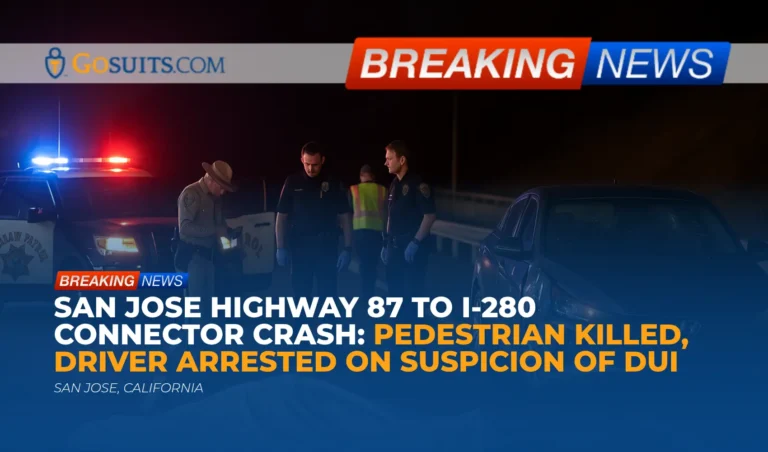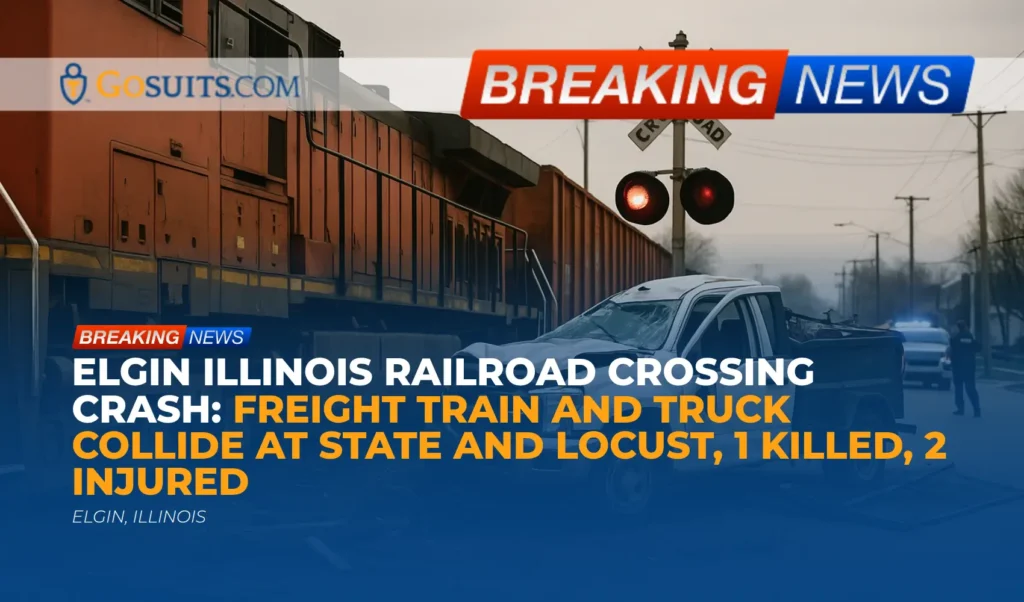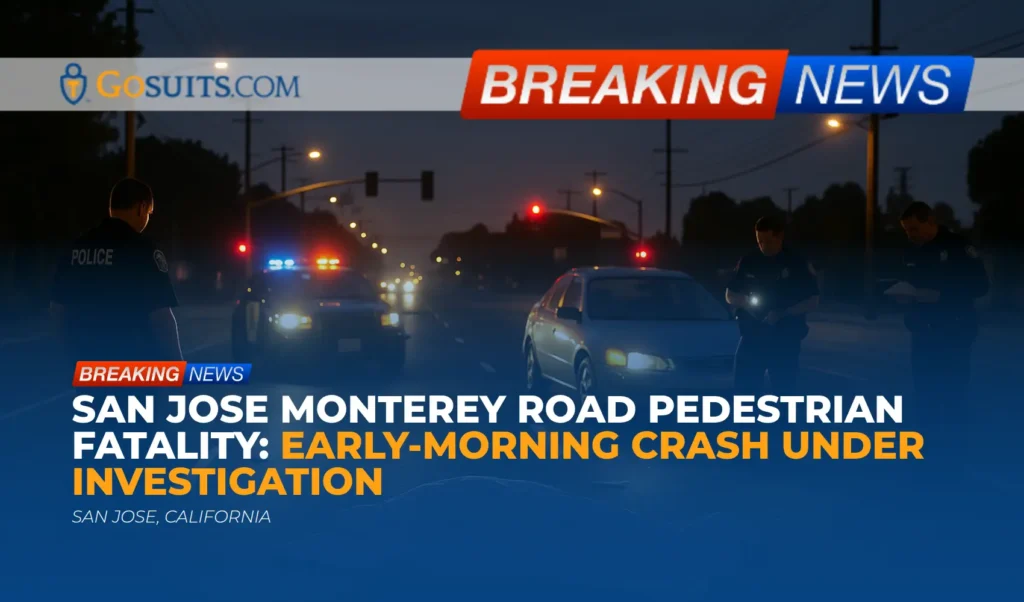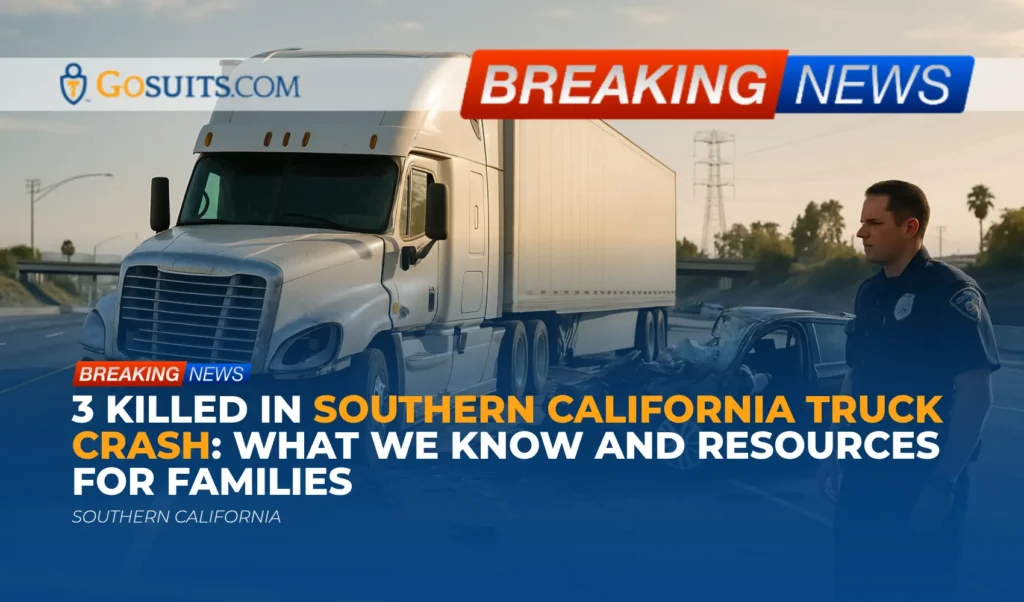- What we know about the Highway 87 to I-280 connector fatality in San Jose
- Agencies involved and how to obtain official records
- Legal context in California after a suspected DUI pedestrian fatality
- Insurance considerations and common pitfalls
- Evidence to preserve and why time matters
- Safety and public health context
- Next practical steps families often take
- Commentary from Gosuits San Jose, California Personal Injury Attorney
- Why taking action promptly can change outcomes
What we know about the Highway 87 to I-280 connector fatality in San Jose
A deadly collision occurred on Wednesday evening, October 23, 2025, at approximately 7:20 p.m., on the transition ramp from northbound Highway 87 to northbound Interstate 280 near downtown San Jose. According to the California Highway Patrol (CHP), a 52-year-old San Jose man driving a 2021 Hyundai lost control and struck a man who was standing on the right shoulder of the connector. The injured pedestrian, believed to be in his early to mid 40s, died at the scene. The driver was arrested on suspicion of driving under the influence of alcohol. As of the latest report, officials had not released the pedestrian’s name pending identification and notification of next of kin by the Santa Clara County Medical Examiner-Coroner’s Office. CHP Officer Ross Lee said it was not immediately clear why the victim was on the freeway connector; that remains under investigation. Anyone with information is asked to contact the CHP San Jose Area field office at 408-961-0900.
This article is intended to help community members understand the process that often follows a fatal roadway incident, including how families typically obtain essential records, the civil law backdrop in California, and practical steps that may help preserve rights while the investigation is ongoing.
Agencies involved and how to obtain official records
California Highway Patrol (CHP) traffic collision report
The primary investigative agency for freeway and state route collisions in this area is the California Highway Patrol. Families and their representatives commonly request the CHP Traffic Collision Report, which documents responding officers’ observations, involved parties, roadway conditions, diagrams, and other preliminary findings.
How to request: CHP provides a standardized request process using Form CHP 190. Instructions, eligibility, and the form are available through the agency’s public webpage. See “Collision Report Request” on the CHP site and the CHP 190 form here: CHP collision report request and CHP 190 form.
For events handled by the San Jose Area office, inquiries can also be made directly to that office. The news release invites anyone with information to call the CHP San Jose Area field office at 408-961-0900. For office location and hours, consult the CHP area office page via chp.ca.gov.
Santa Clara County Medical Examiner-Coroner (ME-C)
In fatal incidents, the Santa Clara County Medical Examiner-Coroner conducts investigation and certifies the cause and manner of death. Autopsy and coroner records can be requested in accordance with county procedures, and the office handles next-of-kin notifications. The office’s public site provides contact, record request instructions, and policies: Santa Clara County Medical Examiner-Coroner (sccgov.org).
Families often seek the following documents:
- Coroner’s report and autopsy if performed, including findings and toxicology, subject to legal restrictions on disclosure.
- Death certificate and certified copies for estate, insurance, and benefits claims.
Death certificates
Certified copies of the death certificate in Santa Clara County are typically obtained through the Clerk-Recorder’s Office. Guidance and request forms are available here: Santa Clara County Clerk-Recorder.
Press information and updates
CHP typically issues a news release and may provide updates as the investigation proceeds. The initial account indicates the cause of the pedestrian’s presence on the connector is still under review. For official updates, consult CHP’s public information channels at chp.ca.gov.
Public Records Act requests for 911 audio and related materials
California’s Public Records Act allows the public to request certain records from state and local agencies, with exemptions for active investigations, privacy, or safety. Statutory provisions are codified at Government Code sections 7920.000 et seq., available via the state’s code website: California Public Records Act.
Common requests in serious crash cases may include 911 audio, Computer Aided Dispatch logs, photographs, and roadway surveillance if held by public agencies. Processing times and exemptions vary. Requests typically go to the agency that created or maintains the record, such as CHP or the County communications center.
Victim compensation resources
California’s Victim Compensation Board (CalVCB) may help with certain documented expenses after violent crime, including DUI incidents. Covered expenses can include funeral/burial and counseling, subject to eligibility criteria. See California Victim Compensation Board.
Legal context in California after a suspected DUI pedestrian fatality
Wrongful death claims: who can bring them
California’s wrongful death statute identifies who may bring a civil claim for losses resulting from a person’s death. Eligible individuals typically include the decedent’s surviving spouse or registered domestic partner, children, and in some cases other dependents or those entitled to the decedent’s property by intestate succession. See Code of Civil Procedure section 377.60 at the state’s official code site: CCP 377.60.
Survival actions
A survival action allows the decedent’s estate to pursue certain claims the decedent could have brought had they lived, such as pain and suffering in limited circumstances under recent amendments or property damage claims. See Code of Civil Procedure section 377.30: CCP 377.30.
Filing deadlines
Most California wrongful death claims must be filed within two years of the date of death. See Code of Civil Procedure section 335.1: CCP 335.1. Shorter deadlines may apply if a claim involves a public entity (government claims can carry a six-month administrative claim requirement). Assessing which deadline applies is time-sensitive.
DUI, negligence, and negligence per se
Allegations of driving under the influence are significant in civil cases. Under California’s negligence per se doctrine, violation of a safety statute can support a finding of negligence if the violation proximately caused the harm and the injured party was among those the statute protects. This doctrine is codified at Evidence Code section 669: Evidence Code 669.
Driving under the influence is prohibited by the Vehicle Code, including section 23152. Statutory text is available here: Vehicle Code 23152. Although any criminal case proceeds separately, the same facts can be relevant in a civil claim for damages.

Pedestrians on freeways and comparative fault
California restricts pedestrian access on freeways where posted. See Vehicle Code section 21960: Vehicle Code 21960. Even when a pedestrian may have been in a restricted area, California uses comparative fault principles in civil cases. That means a jury can assign percentages of responsibility among involved parties rather than barring recovery entirely. The Judicial Council’s civil jury instructions include guidance on comparative fault: see the California Civil Jury Instructions (CACI) page at courts.ca.gov.
Because fault is not binary, facts such as speed, impairment, lighting, signage, roadway design, and whether a pedestrian was seeking help or dealing with a vehicle emergency can all become important. Investigations often gather data from scene measurements, vehicle data recorders, witness statements, and toxicology.
Dram shop and social host liability is very limited in California
California law generally provides that furnishing alcohol is not the legal cause of injuries resulting from intoxication, with narrow exceptions involving service to obviously intoxicated minors. See Civil Code section 1714 and Business and Professions Code section 25602: Civil Code 1714 and B&P Code 25602. This means claims typically focus on the impaired driver and potentially other non-alcohol-related theories if supported by evidence.
Potential public entity claims
In some cases, families explore whether roadway design, signage, or maintenance played a role. California allows claims against public entities for a dangerous condition of public property if specific legal criteria are met. Such claims trigger short administrative deadlines. Government claims procedures are set out in the Government Code, and different agencies have specific instructions. For an overview of state-level claims procedures, see the Department of General Services information page: How to file a claim against the State of California. Whether a public entity is implicated is highly fact dependent and should not be assumed.
Insurance considerations and common pitfalls
At-fault driver’s liability insurance
A civil claim is usually asserted against the at-fault driver’s automobile liability policy. In DUI fatality cases, evidence of impairment and loss of control often becomes central to the insurer’s evaluation. Insurers frequently reach out early; any statements made can be used to limit or contest claims later. It is prudent to obtain legal guidance before giving recorded statements or signing medical or claim authorizations.
Uninsured/underinsured motorist (UM/UIM) claims
When a pedestrian is struck, the decedent’s own UM/UIM coverage can sometimes apply, even if they were not driving. UM/UIM claims are governed by policy terms that may impose strict notice and consent requirements. Missing a contractual deadline can jeopardize coverage. Early policy review and documentation are important.
Medical payments, funeral benefits, and overlapping remedies
Some auto policies include medical payments coverage that may contribute to funeral or related expenses regardless of fault, subject to policy language. Restitution ordered in a criminal DUI case does not replace civil claims and may be limited in scope and enforceability. Tracking all sources, benefits, and deadlines helps avoid gaps.
Why speaking to insurers first can be risky
- Recorded statements can be parsed to minimize liability or damages.
- Partial releases may waive rights without fully resolving all claims.
- Policy traps such as consent-to-settle clauses can complicate UM/UIM recovery.
Before contacting any insurer, consider consulting a qualified attorney for a free consultation to understand rights and obligations. What is said to an insurer can be used against claimants later.
Evidence to preserve and why time matters
Evidence can degrade or be overwritten quickly after a freeway fatality. Families and their representatives often move promptly to identify and preserve the following:
- Traffic Collision Report and supplemental diagrams from CHP, including any updates.
- Vehicle Event Data Recorder (EDR) from involved vehicles, which may capture speed, braking, throttle, and seatbelt status in the seconds before impact.
- Scene photos and measurements including skid marks, debris fields, lighting, and signage placement.
- Third-party video from nearby traffic cameras where available and private sources such as businesses or dash cameras. Many systems overwrite footage within days.
- Witness information with full contact details and any contemporaneous notes.
- 911 audio and dispatch logs via Public Records Act requests, subject to exemptions. See the Public Records Act statutes.
- Medical and coroner records including autopsy findings and toxicology, where authorized.
In complex or severe crashes, CHP may utilize specialized Multidisciplinary Accident Investigation Teams (MAIT), which conduct in-depth technical investigations. Information about MAIT is available here: CHP MAIT overview. Not every case involves MAIT, but when it does, that work product can be highly informative.
Safety and public health context
Alcohol-impaired driving remains a leading factor in fatal crashes nationwide. NHTSA reports that alcohol-impaired driving fatalities accounted for a significant share of traffic deaths in recent years. National summaries and ongoing data are available from NHTSA: NHTSA: Drunk Driving.
California’s Office of Traffic Safety maintains state-level statistics and trend data on impaired driving, pedestrian safety, and roadway fatalities. See OTS quick stats here: California OTS Quick Stats. These resources show that while enforcement and education remain priorities, impaired driving continues to cause preventable tragedies that devastate families and communities.
On limited-access freeways, pedestrians are generally prohibited for safety reasons, and even an encounter on the shoulder can be catastrophic when high speeds, limited sight distances, and driver impairment intersect. The CHP’s preliminary account in this incident underscores how quickly a loss of control can turn deadly.
Next practical steps families often take
Every situation is unique, and the following list is provided for general information. Families commonly:
- Identify the lead investigating agency and note the incident date, time, location, and report number if available.
- Request the traffic collision report and any supplemental materials from CHP using CHP Form 190, following the instructions at CHP collision report request.
- Coordinate with the Medical Examiner-Coroner for identification, next-of-kin procedures, autopsy findings, and release of remains. See Santa Clara County Medical Examiner-Coroner.
- Obtain certified death certificates for estate, insurance, and benefit matters via the Santa Clara County Clerk-Recorder.
- Document financial impacts including funeral and burial costs, household contributions, and dependent support needs.
- Preserve potential evidence such as photos, videos, and communications. Consider sending preservation letters to involved insurers and, where appropriate, nearby businesses that may hold relevant footage.
- Evaluate available benefits including CalVCB assistance at victims.ca.gov, employer benefits, and applicable insurance coverages.
- Consult a personal injury attorney before speaking with insurers to understand rights, potential claims, and deadlines. Statements to insurers can be used later and may affect the outcome.
If anyone has information that may assist the investigation of this collision, CHP asks that they contact the San Jose Area field office at 408-961-0900.

Commentary from Gosuits San Jose, California Personal Injury Attorney
Our hearts go out to everyone affected by this loss on the Highway 87 to I-280 connector. The grief that follows a sudden crash is immense. This discussion is for educational purposes and general information to help the community understand the civil-law context that often follows a fatal roadway incident.
From a civil perspective, suspected alcohol impairment is a critical factor. California’s negligence per se doctrine recognizes that violations of safety statutes can support a finding of negligence when they cause the kind of harm the statutes are intended to prevent. In alcohol-related collisions, that can have real consequences in a civil claim. At the same time, California uses comparative fault, which means a jury can consider all conduct and conditions that contributed to the crash. Even if questions arise about why a pedestrian was on a freeway connector, that does not end the civil analysis; it is one fact among many in a broader evaluation.
Insurance companies and large corporations understand the claims process deeply and move quickly to shape the narrative. Early recorded statements are sometimes used to narrow liability or undercut damages. Offers can arrive before the full extent of loss is known, especially in wrongful death cases where future support and household services are substantial but not immediately visible. Complex policy provisions, such as consent-to-settle clauses in UM/UIM policies, can also trap the unwary and later restrict recovery.
A free consultation with a seasoned attorney can provide clarity about deadlines, evidence preservation, and how to organize claims while the investigation is active. It can also help avoid missteps that affect insurance coverage and valuation. Speaking with insurers before understanding the legal landscape can make a difficult situation even harder.
Why taking action promptly can change outcomes
- Preserve time-sensitive evidence. Traffic camera footage, dashcam files, and store videos are often overwritten within days. Early outreach to preserve this data can materially change what can be proven later.
- Secure essential records. Collision reports, coroner documents, and certified death certificates are the backbone of many claims. Starting requests early helps align insurance benefits, funeral arrangements, and financial planning.
- Protect insurance rights. Auto policies can impose strict notice requirements, especially for UM/UIM claims. Delays can limit coverage or complicate recovery under policy conditions.
- Avoid damaging statements. Insurers may seek recorded statements quickly. Without a full understanding of the facts and the law, statements can be used to reduce or deny compensation later.
- Calendar legal deadlines. Civil claims have strict statutes of limitation. Some public-entity claims require an administrative filing within six months. Missing a deadline can forfeit the claim.
- Coordinate benefits. CalVCB, employer benefits, and insurance coverages may overlap. Timely, organized documentation prevents gaps and reduces the risk of conflicting positions among payors.
- Plan for the long term. Wrongful death evaluations consider future support and household services. Starting early helps gather employment records, tax documents, and expert analyses needed to accurately describe these losses.
What to do now, at a high level: identify the lead agency and request the collision report; arrange for certified death certificates; preserve any available video and witness information; document expenses and financial impacts; and seek a no-cost legal consultation before engaging with any insurer. Acting promptly helps ensure that key evidence is not lost and that important deadlines are met.
Key official resources referenced
- California Highway Patrol: Collision Report Request
- CHP 190: Request for Collision Report
- Santa Clara County Medical Examiner-Coroner
- Santa Clara County Clerk-Recorder: Vital Records
- California Victim Compensation Board
- Wrongful Death Statute: CCP 377.60
- Survival Actions: CCP 377.30
- Limitations Period: CCP 335.1
- Negligence Per Se: Evidence Code 669
- DUI Statute: Vehicle Code 23152
- Pedestrians on Freeways: Vehicle Code 21960
- California Civil Jury Instructions (CACI)
- California Public Records Act
- Government Claims Information
- NHTSA: Drunk Driving
- California OTS: Quick Stats
- CHP MAIT






